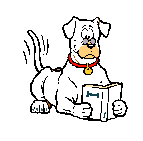 |
Canine Learning Center, Inc. |
| Introducing a Puppy to a Leash and Collar |
 |
Canine Learning Center, Inc. |
| Introducing a Puppy to a Leash and Collar |
Introducing
a Puppy to a Leash and Collar
by
Leah Spitzer
Introducing a puppy to a leash and collar takes just a little finesse and patience. Take your time, follow the steps, and you should be on your way to a puppy that respects his leash and doesnít pull.
1. When I get a puppy, I start with just a lightweight collar. Sometimes, I will even just purchase a little cat collar (without the bell of course). I let the puppy wear the collar when Iím supervising and take it off when I put him back in his crate. He may scratch at it. It feels different. Ignore him. At some point, he will forget that he is wearing it. Then you are ready for step 2.
2.
Now I take a very lightweight leash.
I like to use one that is probably not going to be the right size for him
when he is older. Again I buy the
smallest, lightest weight leash I can find.
Let him drag it
around for a few days while you supervise.
Do this for short periods of time - no longer than 15 minutes - and
always supervise to make sure it doesnít tangle. If it does tangle, the puppy may panic and all your work will
be for naught. Do this for a few days.
3.
Now comes the most important step.
I follow him. I make a
VERY conscious effort to NEVER let the leash get tight.
If he starts running
and looks like he will hit the end of the leash, I run with him until I
can turn him by calling him and offering him treats. I NEVER, repeat I NEVER let the leash get tight.
THIS IS IMPORTANT. At this
stage of the game, allowing a tight leash gets them used to a tight leash and
will actually be teaching them TO PULL. These
are young pups, so it is not really that hard to stay aware and keep it loose. If I want him to turn with me, I call him and encourage
him with a cookie, never the leash.
4. Somewhere around 10-11 weeks, I start applying what is called a vibration. This is hard to describe in writing, but it is literally a very tiny vibration done with the forefinger and thumb. Lay the leash across the palm of your hand and gently take the leash between the thumb and forefinger. Jiggle it lightly a few times to make the leash vibrate. Do not use your wrist or your arm to apply the vibration; jiggle your fingers. Practice with a human friend and get them to tell you when they feel it. I am still not pulling in any direction whatsoever, just vibrating. This gets the pup's attention and when he looks up, I praise him and offer him a treat.
5. Next, I can begin teaching the puppy direction. You can take the vibration technique and begin teaching direction. Apply less than a pound of pressure as you vibrate. So, still using your fingers to vibrate, use your arm to bring the leash toward you one inch. The dog will now feel a vibration in the direction you want him to go, toward you. Praise and reward with a treat.
6. If your pup still insists on barging ahead, just stop dead in your tracks and wait. While you are waiting, apply a vibration to the leash. When leash slackens, praise and simultaneously move forward. It is important that you wait until you can visually see the leash soften before you move forward.
Think about this for a moment. While we canít ever really take the emotions out of dog training, letís simplify for a moment and say we can.
If we can, they we can say this:
dogs do things that get them what they want, and avoid doing things that donít get them what they want. If a puppy is pulling, he is pulling to get from Point A to Point B. Stopping and patiently waiting while he is pulling teaches him that pulling will NOT get him what he wants (Point B). Moving when he is being polite teaches him that moving with a loose leash and no tension will get him to Point B much faster. He may even view it as ďsneaking upĒ on Point B.
Your pup will learn very quickly that if he wants to move forward, he must do it nicely. Let me share a story. When my golden retriever, Diamond, was 6 months old, she went for her 3-month check up at the veterinarian. Now mind you, she had never had tension on the leash. I walked in and she was very polite on her leash. We went to the exam room and the vet tech asked for the leash so she could take Di to get weighed. I handed it to her. The vet tech pulled on the leash. Di planted all four feet in the ground and looked at the vet tech like she was the RUDEST person on this earth! How dare she! Di wouldn't move until I took the leash back and loosened it up and went with her to the scale. Sometimes, the dogs are smarter than us J.
Now, I figure, if Di can teach a human not to pull, then I can teach a dog not to pull using the same methods.
Reprint only with permission of the author.